
Orchidaceae, commonly called the orchid family, is a diverse and widespread family of flowering plants, with blooms that are often colourful and fragrant.

A mycorrhiza is a mutual symbiotic association between a fungus and a plant. The term mycorrhiza refers to the role of the fungus in the plant's rhizosphere, its root system. Mycorrhizae play important roles in plant nutrition, soil biology, and soil chemistry.
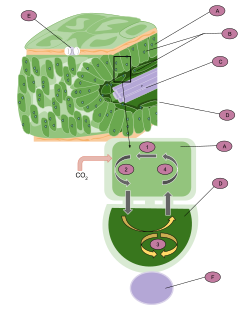
C4 carbon fixation or the Hatch–Slack pathway is one of three known photosynthetic processes of carbon fixation in plants. It owes the names to the 1960's discovery by Marshall Davidson Hatch and Charles Roger Slack that some plants, when supplied with 14CO2, incorporate the 14C label into four-carbon molecules first.

The Russulaceae are a diverse family of fungi in the order Russulales, with roughly 1,900 known species and a worldwide distribution. They comprise the brittlegills and the milk-caps, well-known mushroom-forming fungi that include some edible species. These gilled mushrooms are characterised by the brittle flesh of their fruitbodies.
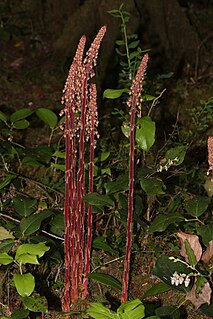
Pterospora, commonly known as pinedrops, woodland pinedrops, Albany beechdrops, or giant bird's nest is a North American genus in the subfamily Monotropoideae of the heath family, and includes only the species Pterospora andromedea. It grows in coniferous or mixed forests. It is widespread across much of Canada as well as the western and northeastern United States to and northern Mexico. Along with Monotropa it is one of the more frequently encountered genera of the Monotropoideae.

Hexalectris is a genus of the family Orchidaceae, comprising 10 known species of fully myco-heterotrophic orchids. These species are found in North America, with the center of diversity in northern Mexico. None of the species are particularly common. Hexalectris spicata has a wide distribution and is likely the most abundant member of the genus, but is nevertheless infrequent throughout its range. Other species are rare, and some, such as H. colemanii, are threatened or endangered. All species that have been studied form associations with ectomycorrhizal fungi that are likely linked to surrounding trees. Many Hexalectris species are found in association with oak trees (Quercus), which are ectomycorrhizal.

Corallorhiza maculata, or spotted coralroot, is a North American coralroot orchid. It has three varieties: C. maculata var. occidentalis, C. maculata var. maculata, and C. maculata var. mexicana. It is widespread through Mexico, Guatemala, Canada, St. Pierre & Miquelon, and much of the western and northern United States. It grows mostly in montane woodlands.
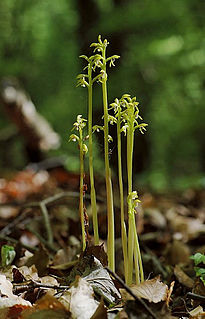
Corallorhiza trifida, commonly known as early coralroot, northern coralroot, or yellow coralroot, is a coralroot orchid native to North America and Eurasia, with a circumboreal distribution. The species has been reported from the United States, Canada, Russia, China, Japan, Korea, India, Nepal, Kashmir, Pakistan, and almost every country in Europe.
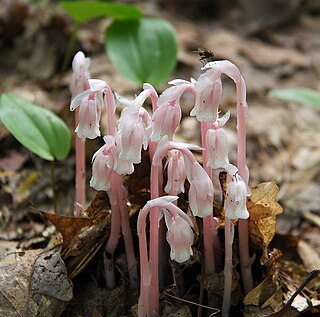
Myco-heterotrophy is a symbiotic relationship between certain kinds of plants and fungi, in which the plant gets all or part of its food from parasitism upon fungi rather than from photosynthesis. A myco-heterotroph is the parasitic plant partner in this relationship. Myco-heterotrophy is considered a kind of cheating relationship and myco-heterotrophs are sometimes informally referred to as "mycorrhizal cheaters". This relationship is sometimes referred to as mycotrophy, though this term is also used for plants that engage in mutualistic mycorrhizal relationships.
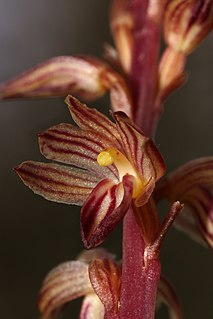
Corallorhiza striata is a species of orchid known by the common names striped coralroot and hooded coralroot. This flowering plant is widespread across much of southern Canada, the northern and western United States, and Mexico. It lives in dry, decaying plant matter on the ground in pine and mixed coniferous forests, and it obtains its nutrients from fungi via mycoheterotrophy.
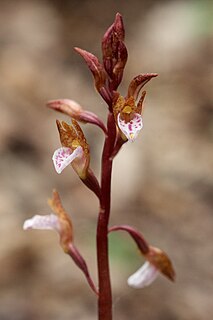
Corallorhiza wisteriana, the spring coralroot, arousing coralroot or Wister's coralroot, is a species of coralroot orchid. It is widespread through much of Mexico as well as parts of the United States.

Corallorhiza mertensiana, or Pacific coralroot, is a coralroot orchid native to the shady conifer forests of northwestern North America. It also goes by the common names Western coralroot and Mertens' coralroot. Corallorhiza mertensiana was previously considered a subspecies of Corallorhiza maculata but was given species rank in 1997 by Freudenstein.
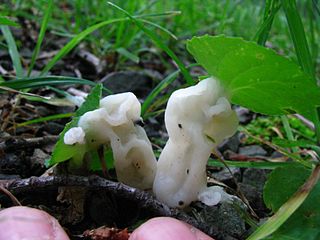
Sebacina is a genus of fungi in the family Sebacinaceae. Its species are mycorrhizal, forming a range of associations with trees, orchids, and other plants. Basidiocarps are produced on soil and litter, sometimes partly encrusting stems of living plants. The fruit bodies are cartilaginous to rubbery-gelatinous and variously effused to coral-shaped. The genus has a cosmopolitan distribution, but fewer than a dozen species are currently recognized worldwide.
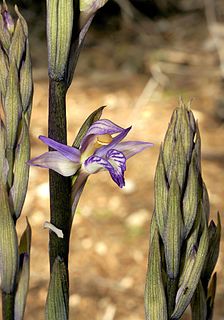
Limodorum is a genus of myco-heterotrophic orchids. All species are temperate terrestrial plants and occur across much of Europe, North-West Africa, the Mediterranean Islands, and as far east as Iran. Plants have evolved away from photosynthesis and as a result their leaves are reduced to scales. There is still chlorophyll present but the plants are believed to be solely dependent on their fungal partner for nutrients. They spend most of their life underground as a short stem with fleshy roots, the unbranched inflorescence can appear in April to June if conditions are favourable.

Corallorhiza odontorhiza, common name fall coral-root or small-flowered coral-root, is a species of orchid widespread across eastern and central United States, and reported also from Mexico, Central America, Quebec and Ontario. In North America, it occurs in forested areas up to an elevation of 2800 m.
Hexalectris arizonica, the spiked crested coralroot or Arizona crested coralroot, is a terrestrial, myco-heterotrophic orchid lacking chlorophyll and subsisting entirely on nutrients obtained from mycorrhizal fungi in the soil. It is native to Arizona, New Mexico, Texas and Coahuila. It is closely related to H. spicata and sometimes regarded as a variety of that species.

Hexalectris spicata, the spiked crested coralroot, is a terrestrial, myco-heterotrophic orchid lacking chlorophyll and subsisting entirely on nutrients obtained from mycorrhizal fungi in the soil. It is native to Arizona, New Mexico, Texas and Coahuila. It is closely related to H. arizonica and the two are sometimes considered varieties of the same species. Hexalectris spicata is endemic to the southern half of the United States from Arizona east to Florida and north to Maryland and the Ohio Valley.
Hexalectris grandiflora, the largeflower crested coralroot or giant coral-root, is a species of orchid native to Mexico from Chihuahua south to Oaxaca, as well as to western and north-central Texas. It is a myco-heterotrophic species, lacking chlorophyll and subsisting entirely on nutrients obtained by fungi in the soil.
Orchid mycorrhizae are symbiotic relationships between the roots of plants of the family Orchidaceae and a variety of fungi. All orchids are myco-heterotrophic at some point in their life cycle. Orchid mycorrhizae are critically important during orchid germination, as an orchid seed has virtually no energy reserve and obtains its carbon from the fungal symbiont.
Some types of lichen are able to fix nitrogen from the atmosphere. This process relies on the presence of cyanobacteria as a partner species within the lichen. The ability to fix nitrogen enables lichen to live in nutrient-poor environments. Lichen can also extract nitrogen from the rocks on which they grow.























